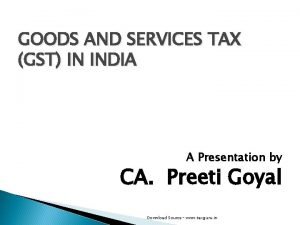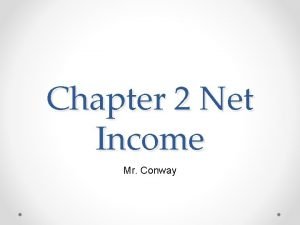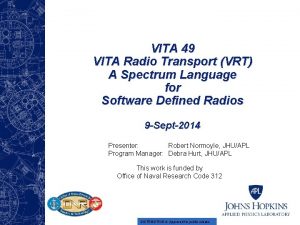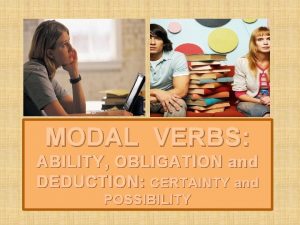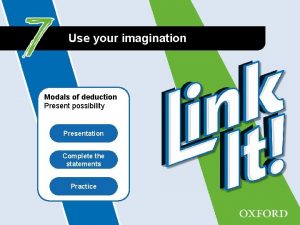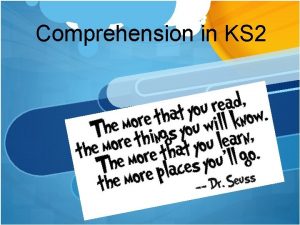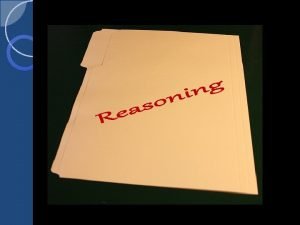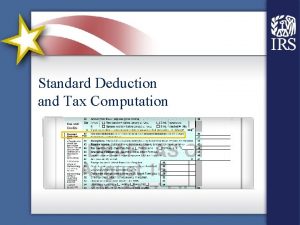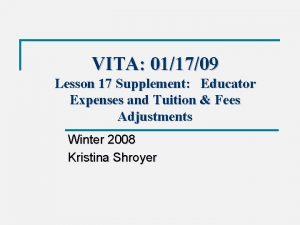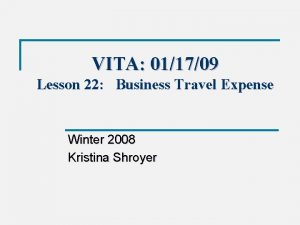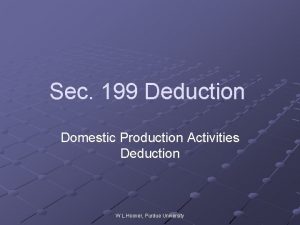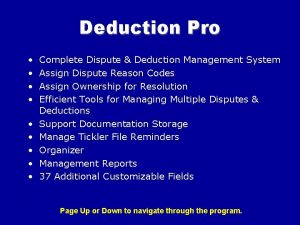VITA 011709 Lesson 19 Standard Deduction and Tax









- Slides: 9

VITA: 01/17/09 Lesson 19: Standard Deduction and Tax Computation Winter 2008 Kristina Shroyer

Lesson 19: Standard Deduction & Tax Computation l l l Standard Deduction and Tax Computation We've now gone over how to complete Page 1 of the Form 1040 Now we're going to focus on deductions and how to compute Taxable income (we'll also see how to calculate tax). n l Lines 38 -44 This is the basic taxable income formula: – = – Income from all sources Exempt income/Exclusions GROSS INCOME Deductions for AGI Deductions from AGI (Greater of Itemized or Standard Deduction) – Personal and Dependency Deductions = TAXABLE INCOME

Lesson 19: Deductions l What are deductions? n Deductions are subtracted from a taxpayer's AGI (adjusted gross income) ♦ l Most taxpayers have a choice between taking the standard deduction or itemizing their deductions n If the taxpayer has a choice they want to choose the deduction method resulting in the lower tax ♦ l So if the standard deduction is higher they should take that and if the itemized deduction is higher the taxpayer should itemize What is the standard deduction? n n This is the simpler of the two to compute Basically it is a predefined dollar amount for taxpayers to deduct from AGI based on their: ♦ ♦ n l They reduce tax filing status whether they are 65 or older and/or blind whether they paid real estate taxes (new this year) whether they can be claimed as a dependent by another taxpayer Eliminates the need to keep records (itemizing requires records) See Tab F in your Volunteer Resource Guide and look at the exercises n n Look at the second chart on page F-1 Assume for the exercises the taxpayers are not over age 65 or blind

Lesson 19: Deductions l What is an Itemized Deduction? n n A standard deduction is a predetermined amount the taxpayer deducts based on a few factors like filing status Itemized Deductions are also subtracted from a taxpayers AGI. ♦ However, itemized deductions are based on specific personal expenses of the taxpayer Ø Ø n If a taxpayers itemized deductions are greater than the standard deduction for that taxpayer they should itemize their deductions ♦ l Higher deductions lead to lower taxable income and lower tax In general taxpayers benefit from itemizing deductions if they: n n n l will be different for each taxpayer based on a number of factors taxpayer must keep records of these personal expenses have mortgage interest have large (VERY large) unreimbursed medical expenses have large unreimbursed business expenses or charitable donations We'll cover itemized deductions in the next lesson

Lesson 19: Standard Deduction l Who cannot take the Standard Deduction? n n Most taxpayers have a choice and will want to take the greater of the standard deduction or itemized deductions but some do not Taxpayers that MUST itemize: ♦ ♦ l Filing status of MFS and the spouse itemizes Nonresident or dual-status alien during the year and not married to a US Citizen or resident at the end of the year How does age and blindness affect the standard deduction? n The standard deduction is higher if the taxpayer and/or spouse is 65 or older The standard deduction is higher if the taxpayer and/or spouse is blind Look at page 2 of 1040, boxes are checked to indicate these things on line 39 a n Taxpayers qualify as being 65 or older: n n ♦ ♦ n If they are 65 or older at the end of the tax year For this purpose they are considered to be age 65 on the day before their 65 th birthday If a taxpayer died during the year and are over 65 they get the additional deduction, if the taxpayer was not 65 at the time of death they do not get the additional deduction Magic date – must be born before Jan 2, 1944 What qualifies as blind? - See page 19 -4

Lesson 19: Standard Deduction l How to compute the standard deduction? n Use the worksheet in Tab F of your Volunteer Resource Guide (page F-2) ♦ l What about individuals that can be claimed as dependents? n n The standard deduction is generally lower for individuals claimed as dependents by another taxpayer The deduction is generally limited to the greater of: ♦ ♦ n n l Let's look at it now and look at the Exercises and page 19 -5 $900 –or. The individual's earned income for the year plus $300 (but not more than the regular standard deduction Again use the worksheet (it will be in Tax. Wise also) See example page 19 -6 What about individuals that paid real estate taxes but do not itemize? n n n New this year! Taxpayers who use the standard deduction are allowed an additional standard deduction for paying state and local property taxes Again use the worksheet

Lesson 19: Deductions l Which to use – Standard or Itemized? n n The taxpayer will benefit from taking the higher of the standard or itemized deductions In the interview determine if any of the points on page 19 -6 are applicable to see if the taxpayer could benefit from itemizing deductions ♦ n l Let's look at the questions Tax. Wise automatically selects the better deduction so you want to enter the information the taxpayer gives you for itemized even though they may not qualify Where to enter the standard deduction? n Once you've completed the worksheet it goes on line 40 of form 1040

l Lesson 19: Taxable Income and Tax Calculating Taxable Income (line 43) l We looked at the formula in the second slide for Taxable Income l To calculate Taxable Income subtract the following from AGI n n Personal and Dependency Exemptions (line 42) The Standard Deduction or the Itemized Deduction (line 40) l Taxable Income is reported on line 43 l Let's go through what we did so far on page 2 of form 1040 l Example page 19 -7

l Lesson 19: Taxable Income and Tax Determining the Tax (line 44) l Tax is based on the amount of Taxable Income on line 43 l How to calculate n If taxable income is less than $100, 000 use the tax tables ♦ ♦ n Form 4491 -W, Appendix B, page 183 You just look up the taxable income and the appropriate filing status to get the tax amount If taxable in come is $100, 000 or more use the Tax Computation Worksheet ♦ Form 1040 instructions page 80 l Example Page 19 -7 l There are some exceptions to this but these types of taxpayers won't qualify for VITA l In addition, Tax. Wise will do this calculation for you

